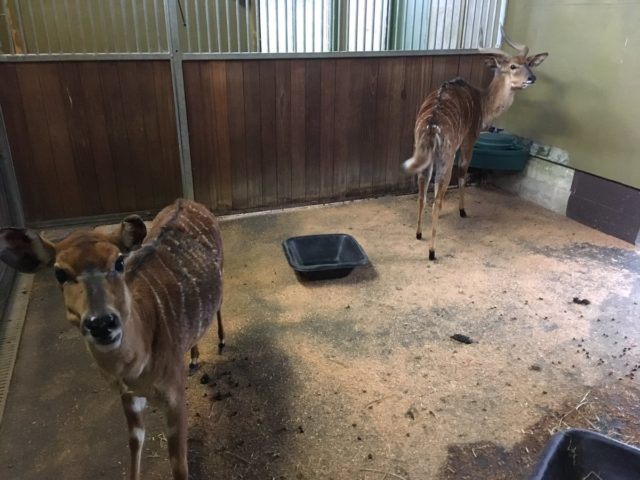
An innovative system using thermal imaging cameras to control indoor heating for zoo animals has been developed to cut energy bills and carbon emissions.
The partnership between Marwell Zoo, Hampshire, and IBM is using infrared sensors to record the temperature every second from across the bedding area of the shelter for southern African antelope known as nyala.
The information is fed back to a computer program which has been “trained” to recognise from the data whether the nyala are in the animal house and if the heating needs to be on.
It is hoped the technology will be able to reduce the amount of time the heaters need to be on during the colder months by 30% to 40%, saving on the zoo’s energy bills and cutting carbon emissions.
It is being tried out in the nyala house, but could be used for a wide range of the zoo’s animals including the okapi, buffalo, Arabian oryx and even the flamingos.

The herd of five female and two male nyala have an indoor area with the door open to their paddock to allow them access to the outside.
Their bedding area has spot heaters which are put on overnight in the autumn and spring, and are on all the time at the height of winter.
But Duncan East, head of sustainability at Marwell, said: “Animals don’t sleep through the night like people do, they might doze for an hour and be active again, so there’s lots of time when they’re not under the heater.”
Motion sensors to switch on the heaters when the animals come inside would not work as they would not pick up on the presence of animals when they are asleep, he said.
But analysis of the new system suggests it is accurate more than 95% of the time, the developers said.
IBM's pioneering heating application uses #Infrared cameras and #RaspberryPi to detect the Nyala antelopes in their enclousures at @Marwellwildlife Stay tuned for more! pic.twitter.com/HHBzbe6G06
— IBM United Kingdom (@IBM_UK_news) January 19, 2018
The next step will be to link up the program to the heater to switch it on and off automatically, in around mid-February, to test out the system fully.
“In terms of savings on our electricity bill, early indications are that we can expect savings of around 30% to 40%.
“It means the organisation will have more money spare to spend on conservation activities or on further developments around the park,” Mr East said.
Inspiration for the idea came from IBM’s offices in Munich where the thermal imaging was used to monitor the queue for the coffee bar, with an LED display showing staff when it was a quiet time to get their hot drinks
Prof Andy Stanford-Clark, chief technology officer at IBM UK and Ireland, who created the prototype and printed the plastic casing for the sensor on his 3D printer at home, said there was a lot of interest from other zoos to see how effective it is and what the potential savings are.
He added: “It makes me feel really good about having done something good for the planet, saving carbon, saving costs for Marwell which is a charity, and making the animals comfortable, using ‘internet of things’ technology.”
He said the technology could have many applications, from switching on and off lights at train stations and offices, to an app to tell people where to head in the zoo depending on which animals are out of their houses and in the paddocks.


Comments: Our rules
We want our comments to be a lively and valuable part of our community - a place where readers can debate and engage with the most important local issues. The ability to comment on our stories is a privilege, not a right, however, and that privilege may be withdrawn if it is abused or misused.
Please report any comments that break our rules.
Read the rules here